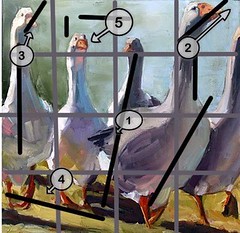
I do this quite a bit, analyze others' work. If you take it apart, you can start to understand why it works, and use these insights in your own artwork to strengthen it. So, without further ado, here is some of what I found (the lines might not be totally straight, I apologize).

1. This is where my eye initially catches in the painting. Carol has put the lightest value in the painting right next to the darkest value, creating a strong contrast thar will attract the eye. She also did a good job of not placing it directly in the center. A lot of teachers would recommend putting it further down and gurner to the left or right, but it works here because of the secondary focal point (#5), which is mire in the spot that the rule of thirds recommends.
2. Rather than have the viewer's eye get stuck from such a centralized focal point, my eye is drawn up the swan's body, to the head, end of the beak,and out of the painting. This is good. You want your viewer's eye to move around the painting, so they don't get bored.
3. Although my eye is moved out of the painting with #2, it is brought back in with the angle of the head and the light hitting the swan's head on the far left. My eye then moves down the body again, to the feet, where it hits:
4. The shadows. These shadows are a powerful feature of this painting. The strong lighting is reinforced by the shadows, and they continue to create a very pleasing rhythm. Imagine if the light were coming from the other direction - none of the forms would be defined nearly as well, and most of the ground shadows would be lost in the feet! Carol picked the perfect lighting angle for this piece.
5. After the ground shadows, my eye heads to the central swan, which thankfully is in the back. Otherwise, if he were in front, he would take up too much attention because of being in the center, and the composition would not be as successful. The angle of his head then leads my eye to the secondary (and much more interesting) focal point.
Ack! I haven't even touched the wonderful interaction between colors, but this composition just absolutely intrigued me. The viewer's eye is lead around, so they don't become bored, but it is not so complex as to be confusing. Great job, all great decisions.
- Posted from my iPad

Wow. So interesting. Love the critique. Wish I could tell you that I took all those things into consideration. I just loved the photo I took and cropped it down to a composition that I liked. Maybe I innately took many of those things into consideration when I was cropping. The photo was much bigger. Thanks so much for your interest and comments.
ReplyDeletewhat a wonderful dissection of a painting. The values in this are beautiful. One of my favorite things is painting white.
ReplyDelete